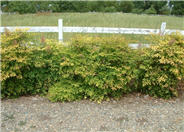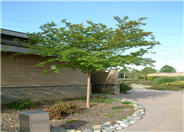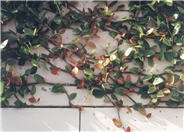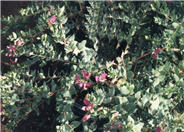
Common name:Compact Lacy Nandina
Botanical name:Nandina domestica 'Compacta'
The dwarf heavenly bamboo is an evergreen shrub that grows 4'-5' tall and 3' wide. It has green and bronze foliage that turns red in the winter. Red berries appear in fall and winter. It is resistant to oak root fungus and hardy to 10 degrees F. Small white flowers appear in spring. It prefers full to part sun with a moderate amount of watering, more during hot summer areas. It is deer resistant and looks great in woodland theme gardens.

Common name:Crape Myrtle
Botanical name:Lagerstroemia indica
The new leaves of this species are 2" long, bright green, and tinged with bronze. Some cultivars have spectacular fall color. When it has a bare outline, its rounded seed capsules add interest. Its delicate flowers bloom in 6"-12" long clusters. The flower colors could be shades of red, rose, pink, purple, and white, blooming in summer. It thrives on heat, and new cultivars have been created that resist mildew. This tree prefers full sun and has low watering needs once it's established.

Common name:Creeping Fig
Botanical name:Ficus pumila
This is one of the few plants that can attach itself securely to wood, masonry, or metal. Because there is no limit to its size, it can overcome an entire buliding. It is most often found in colder climates. This vine will not clim on southern or western walls.

Common name:Sweet Pea Shrub
Botanical name:Polygala X dalmaisiana
This evergreen shrub grows 3'-5' tall. Its leaves are gray green and narrow. Flowers produced are pea-like, with a purplish-pink color from summer through fall. Flowers are great in arrangements. This is a great plant if you need color quickly. Plants are not long lasting but worth the effort. Prune in winter to tidy this shrub.
| Designer: Susan Stiltz | Table and Chairs |
Photographer: GardenSoft |
Soils and Compost:
Maintain a two to four inch layer of mulch on the soil surface to reduce weeds, infiltrate rain water, and reduce compaction.
Water Saving Tip:
Replace turf with groundcovers, trees, and shrubs. If you have areas where no one uses the grass, patches that do not grow well, or a turf area too small to water without runoff, consider replacing the turf with water-efficient landscaping.
Integrated Pest Management:
Drip and other smart irrigation delivers water directly to roots, allowing no excess water for weeds.

